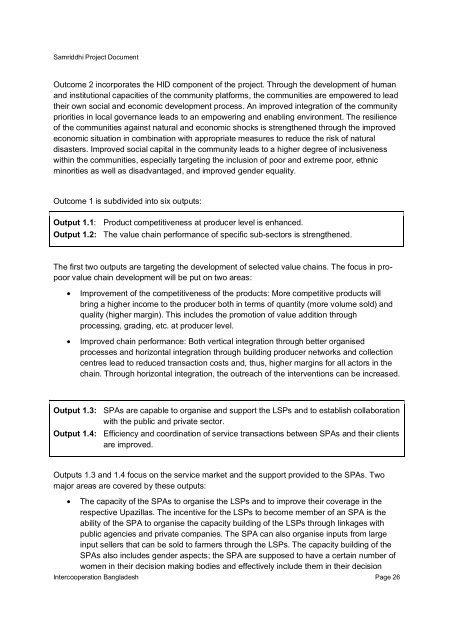Samriddhi
Samriddhi
Samriddhi
Create successful ePaper yourself
Turn your PDF publications into a flip-book with our unique Google optimized e-Paper software.
<strong>Samriddhi</strong> Project Document<br />
Outcome 2 incorporates the HID component of the project. Through the development of human<br />
and institutional capacities of the community platforms, the communities are empowered to lead<br />
their own social and economic development process. An improved integration of the community<br />
priorities in local governance leads to an empowering and enabling environment. The resilience<br />
of the communities against natural and economic shocks is strengthened through the improved<br />
economic situation in combination with appropriate measures to reduce the risk of natural<br />
disasters. Improved social capital in the community leads to a higher degree of inclusiveness<br />
within the communities, especially targeting the inclusion of poor and extreme poor, ethnic<br />
minorities as well as disadvantaged, and improved gender equality.<br />
Outcome 1 is subdivided into six outputs:<br />
Output 1.1: Product competitiveness at producer level is enhanced.<br />
Output 1.2: The value chain performance of specific sub-sectors is strengthened.<br />
The first two outputs are targeting the development of selected value chains. The focus in propoor<br />
value chain development will be put on two areas:<br />
• Improvement of the competitiveness of the products: More competitive products will<br />
bring a higher income to the producer both in terms of quantity (more volume sold) and<br />
quality (higher margin). This includes the promotion of value addition through<br />
processing, grading, etc. at producer level.<br />
• Improved chain performance: Both vertical integration through better organised<br />
processes and horizontal integration through building producer networks and collection<br />
centres lead to reduced transaction costs and, thus, higher margins for all actors in the<br />
chain. Through horizontal integration, the outreach of the interventions can be increased.<br />
Output 1.3: SPAs are capable to organise and support the LSPs and to establish collaboration<br />
with the public and private sector.<br />
Output 1.4: Efficiency and coordination of service transactions between SPAs and their clients<br />
are improved.<br />
Outputs 1.3 and 1.4 focus on the service market and the support provided to the SPAs. Two<br />
major areas are covered by these outputs:<br />
• The capacity of the SPAs to organise the LSPs and to improve their coverage in the<br />
respective Upazillas. The incentive for the LSPs to become member of an SPA is the<br />
ability of the SPA to organise the capacity building of the LSPs through linkages with<br />
public agencies and private companies. The SPA can also organise inputs from large<br />
input sellers that can be sold to farmers through the LSPs. The capacity building of the<br />
SPAs also includes gender aspects; the SPA are supposed to have a certain number of<br />
women in their decision making bodies and effectively include them in their decision<br />
Intercooperation Bangladesh Page 26
















